Evaluation of Performance Management System: Star Entertainment Group
VerifiedAdded on 2023/06/05
|11
|3186
|292
Report
AI Summary
This report critically examines the performance management system (PMS) of the Star Entertainment Group, formerly known as the Echo Entertainment Group. It begins with an overview of the organization's history, structure, strategic goals, and its human resource management (HRM) approach. The report then delves into the specifics of the PMS, including its policies, strategies, tools, and procedures. A key component of the report involves a thorough evaluation of the PMS, assessing its validity, reliability, cost-effectiveness, and fairness. The evaluation highlights issues such as subjectivity in performance assessments, inefficiencies in processes, and a lack of stable leadership capabilities. Based on these findings, the report provides several recommendations to address the identified problems, including the need for fairer and more objective evaluation methods, streamlining operational processes to improve efficiency, and enhancing leadership capabilities. The report concludes by summarizing the key findings and emphasizing the importance of implementing the recommended changes to improve the overall effectiveness of the PMS within the Star Entertainment Group.
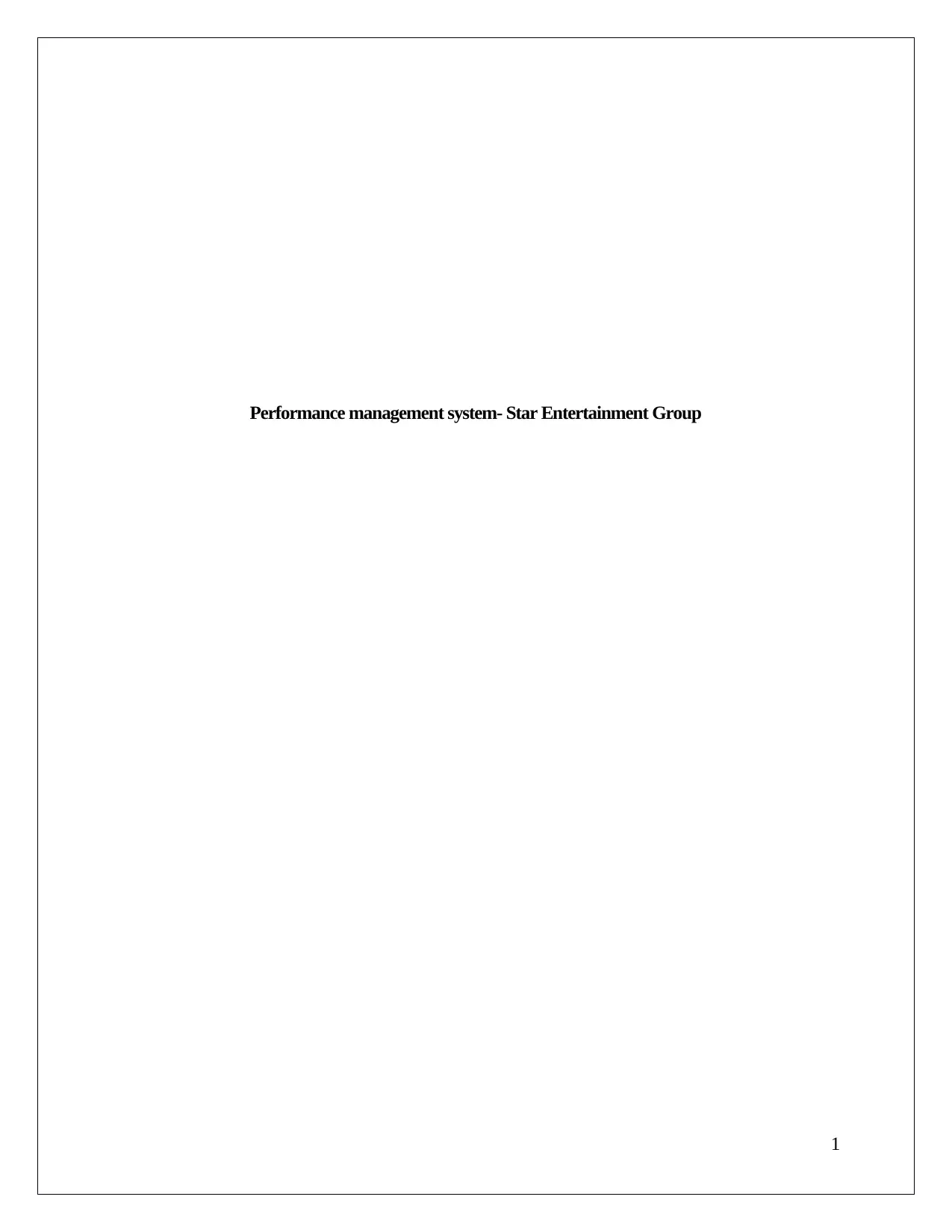
Performance management system- Star Entertainment Group
1
1
Paraphrase This Document
Need a fresh take? Get an instant paraphrase of this document with our AI Paraphraser
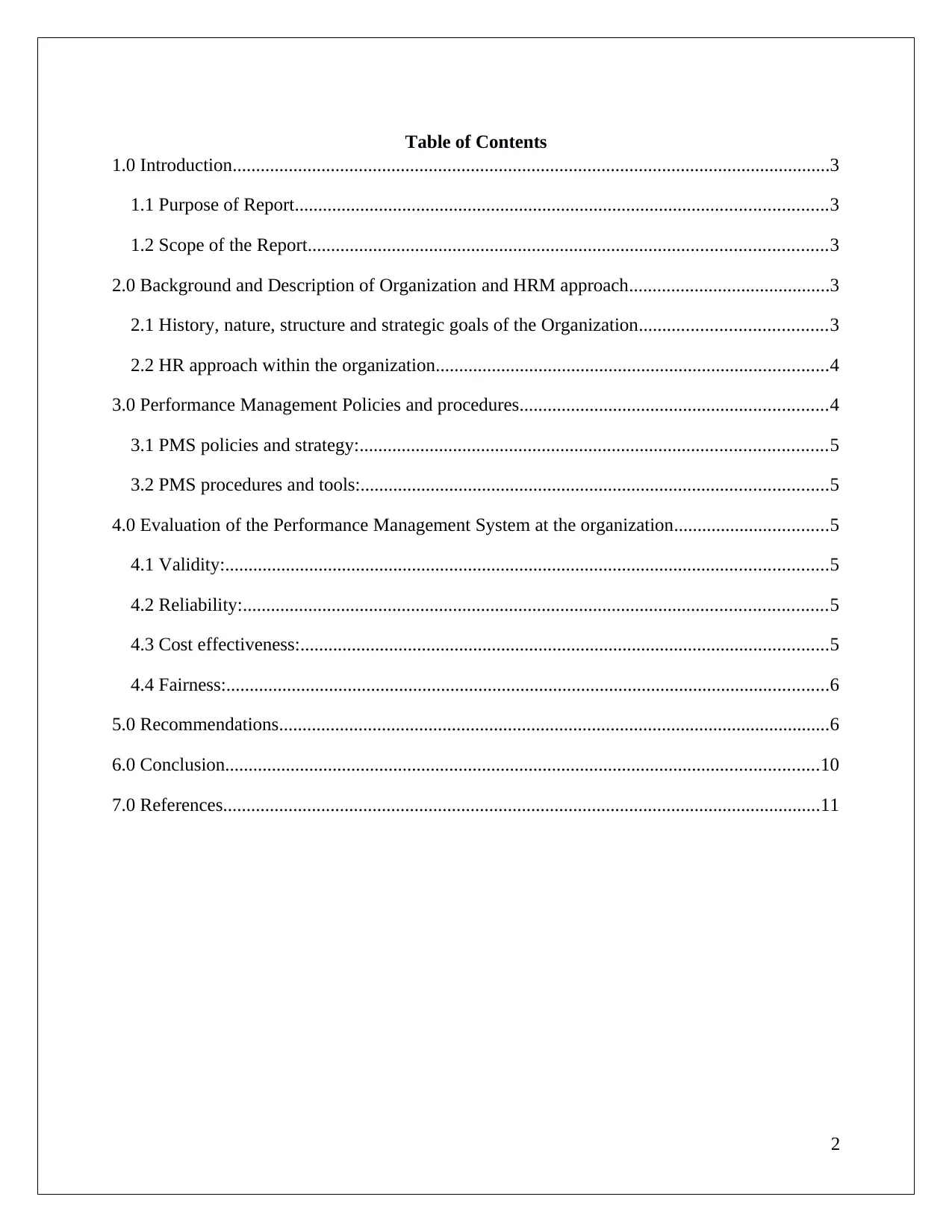
Table of Contents
1.0 Introduction................................................................................................................................3
1.1 Purpose of Report..................................................................................................................3
1.2 Scope of the Report...............................................................................................................3
2.0 Background and Description of Organization and HRM approach...........................................3
2.1 History, nature, structure and strategic goals of the Organization........................................3
2.2 HR approach within the organization....................................................................................4
3.0 Performance Management Policies and procedures..................................................................4
3.1 PMS policies and strategy:....................................................................................................5
3.2 PMS procedures and tools:....................................................................................................5
4.0 Evaluation of the Performance Management System at the organization.................................5
4.1 Validity:.................................................................................................................................5
4.2 Reliability:.............................................................................................................................5
4.3 Cost effectiveness:.................................................................................................................5
4.4 Fairness:.................................................................................................................................6
5.0 Recommendations......................................................................................................................6
6.0 Conclusion...............................................................................................................................10
7.0 References................................................................................................................................11
2
1.0 Introduction................................................................................................................................3
1.1 Purpose of Report..................................................................................................................3
1.2 Scope of the Report...............................................................................................................3
2.0 Background and Description of Organization and HRM approach...........................................3
2.1 History, nature, structure and strategic goals of the Organization........................................3
2.2 HR approach within the organization....................................................................................4
3.0 Performance Management Policies and procedures..................................................................4
3.1 PMS policies and strategy:....................................................................................................5
3.2 PMS procedures and tools:....................................................................................................5
4.0 Evaluation of the Performance Management System at the organization.................................5
4.1 Validity:.................................................................................................................................5
4.2 Reliability:.............................................................................................................................5
4.3 Cost effectiveness:.................................................................................................................5
4.4 Fairness:.................................................................................................................................6
5.0 Recommendations......................................................................................................................6
6.0 Conclusion...............................................................................................................................10
7.0 References................................................................................................................................11
2
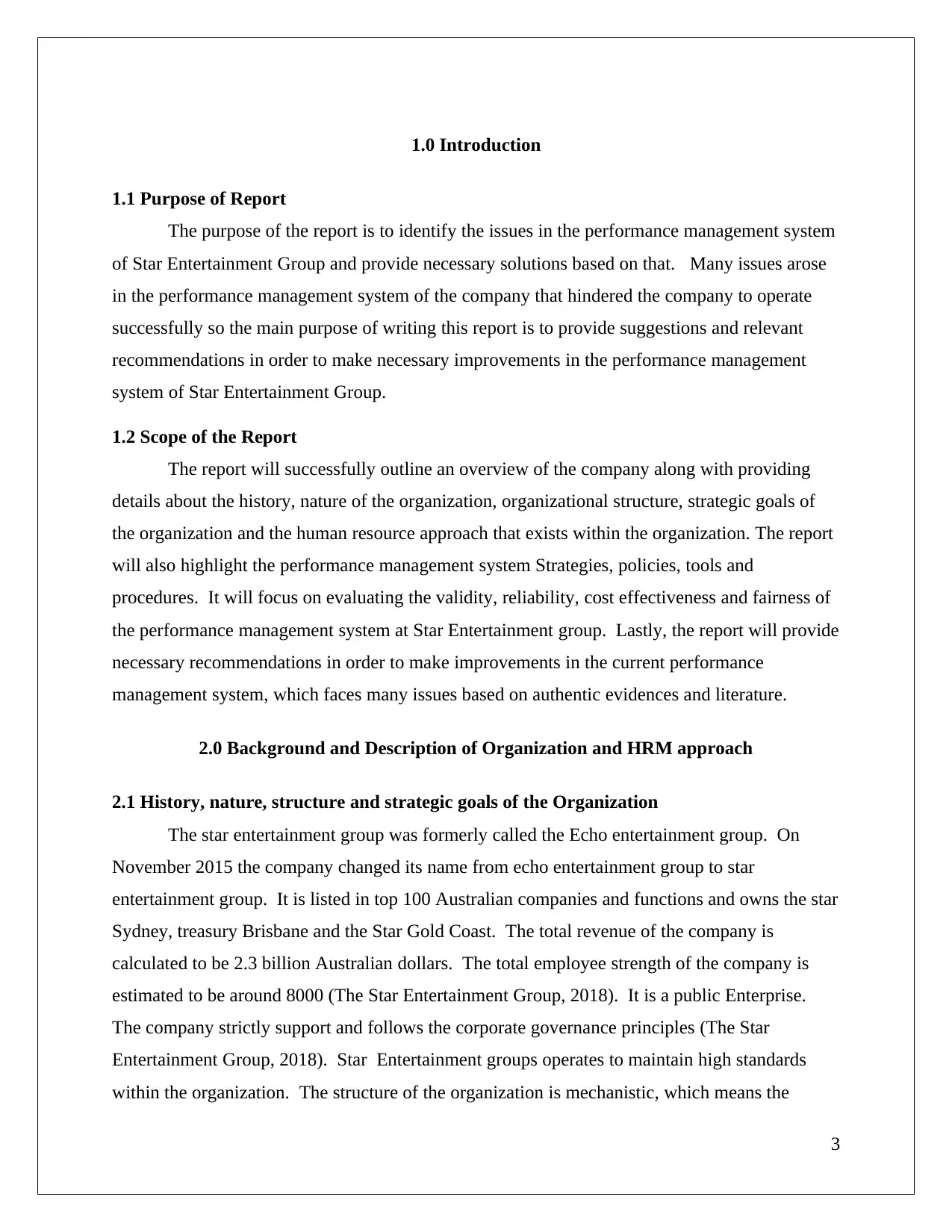
1.0 Introduction
1.1 Purpose of Report
The purpose of the report is to identify the issues in the performance management system
of Star Entertainment Group and provide necessary solutions based on that. Many issues arose
in the performance management system of the company that hindered the company to operate
successfully so the main purpose of writing this report is to provide suggestions and relevant
recommendations in order to make necessary improvements in the performance management
system of Star Entertainment Group.
1.2 Scope of the Report
The report will successfully outline an overview of the company along with providing
details about the history, nature of the organization, organizational structure, strategic goals of
the organization and the human resource approach that exists within the organization. The report
will also highlight the performance management system Strategies, policies, tools and
procedures. It will focus on evaluating the validity, reliability, cost effectiveness and fairness of
the performance management system at Star Entertainment group. Lastly, the report will provide
necessary recommendations in order to make improvements in the current performance
management system, which faces many issues based on authentic evidences and literature.
2.0 Background and Description of Organization and HRM approach
2.1 History, nature, structure and strategic goals of the Organization
The star entertainment group was formerly called the Echo entertainment group. On
November 2015 the company changed its name from echo entertainment group to star
entertainment group. It is listed in top 100 Australian companies and functions and owns the star
Sydney, treasury Brisbane and the Star Gold Coast. The total revenue of the company is
calculated to be 2.3 billion Australian dollars. The total employee strength of the company is
estimated to be around 8000 (The Star Entertainment Group, 2018). It is a public Enterprise.
The company strictly support and follows the corporate governance principles (The Star
Entertainment Group, 2018). Star Entertainment groups operates to maintain high standards
within the organization. The structure of the organization is mechanistic, which means the
3
1.1 Purpose of Report
The purpose of the report is to identify the issues in the performance management system
of Star Entertainment Group and provide necessary solutions based on that. Many issues arose
in the performance management system of the company that hindered the company to operate
successfully so the main purpose of writing this report is to provide suggestions and relevant
recommendations in order to make necessary improvements in the performance management
system of Star Entertainment Group.
1.2 Scope of the Report
The report will successfully outline an overview of the company along with providing
details about the history, nature of the organization, organizational structure, strategic goals of
the organization and the human resource approach that exists within the organization. The report
will also highlight the performance management system Strategies, policies, tools and
procedures. It will focus on evaluating the validity, reliability, cost effectiveness and fairness of
the performance management system at Star Entertainment group. Lastly, the report will provide
necessary recommendations in order to make improvements in the current performance
management system, which faces many issues based on authentic evidences and literature.
2.0 Background and Description of Organization and HRM approach
2.1 History, nature, structure and strategic goals of the Organization
The star entertainment group was formerly called the Echo entertainment group. On
November 2015 the company changed its name from echo entertainment group to star
entertainment group. It is listed in top 100 Australian companies and functions and owns the star
Sydney, treasury Brisbane and the Star Gold Coast. The total revenue of the company is
calculated to be 2.3 billion Australian dollars. The total employee strength of the company is
estimated to be around 8000 (The Star Entertainment Group, 2018). It is a public Enterprise.
The company strictly support and follows the corporate governance principles (The Star
Entertainment Group, 2018). Star Entertainment groups operates to maintain high standards
within the organization. The structure of the organization is mechanistic, which means the
3
⊘ This is a preview!⊘
Do you want full access?
Subscribe today to unlock all pages.

Trusted by 1+ million students worldwide
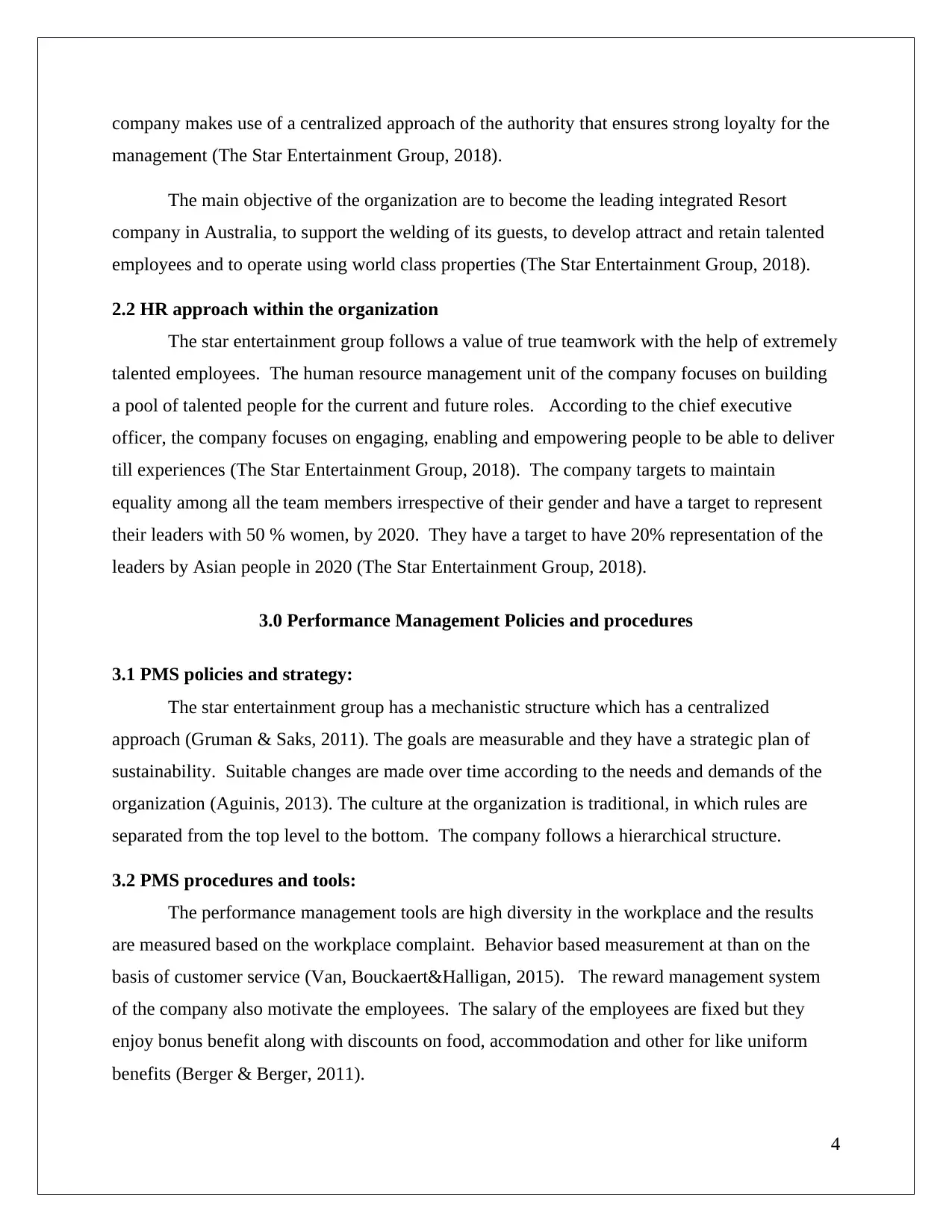
company makes use of a centralized approach of the authority that ensures strong loyalty for the
management (The Star Entertainment Group, 2018).
The main objective of the organization are to become the leading integrated Resort
company in Australia, to support the welding of its guests, to develop attract and retain talented
employees and to operate using world class properties (The Star Entertainment Group, 2018).
2.2 HR approach within the organization
The star entertainment group follows a value of true teamwork with the help of extremely
talented employees. The human resource management unit of the company focuses on building
a pool of talented people for the current and future roles. According to the chief executive
officer, the company focuses on engaging, enabling and empowering people to be able to deliver
till experiences (The Star Entertainment Group, 2018). The company targets to maintain
equality among all the team members irrespective of their gender and have a target to represent
their leaders with 50 % women, by 2020. They have a target to have 20% representation of the
leaders by Asian people in 2020 (The Star Entertainment Group, 2018).
3.0 Performance Management Policies and procedures
3.1 PMS policies and strategy:
The star entertainment group has a mechanistic structure which has a centralized
approach (Gruman & Saks, 2011). The goals are measurable and they have a strategic plan of
sustainability. Suitable changes are made over time according to the needs and demands of the
organization (Aguinis, 2013). The culture at the organization is traditional, in which rules are
separated from the top level to the bottom. The company follows a hierarchical structure.
3.2 PMS procedures and tools:
The performance management tools are high diversity in the workplace and the results
are measured based on the workplace complaint. Behavior based measurement at than on the
basis of customer service (Van, Bouckaert&Halligan, 2015). The reward management system
of the company also motivate the employees. The salary of the employees are fixed but they
enjoy bonus benefit along with discounts on food, accommodation and other for like uniform
benefits (Berger & Berger, 2011).
4
management (The Star Entertainment Group, 2018).
The main objective of the organization are to become the leading integrated Resort
company in Australia, to support the welding of its guests, to develop attract and retain talented
employees and to operate using world class properties (The Star Entertainment Group, 2018).
2.2 HR approach within the organization
The star entertainment group follows a value of true teamwork with the help of extremely
talented employees. The human resource management unit of the company focuses on building
a pool of talented people for the current and future roles. According to the chief executive
officer, the company focuses on engaging, enabling and empowering people to be able to deliver
till experiences (The Star Entertainment Group, 2018). The company targets to maintain
equality among all the team members irrespective of their gender and have a target to represent
their leaders with 50 % women, by 2020. They have a target to have 20% representation of the
leaders by Asian people in 2020 (The Star Entertainment Group, 2018).
3.0 Performance Management Policies and procedures
3.1 PMS policies and strategy:
The star entertainment group has a mechanistic structure which has a centralized
approach (Gruman & Saks, 2011). The goals are measurable and they have a strategic plan of
sustainability. Suitable changes are made over time according to the needs and demands of the
organization (Aguinis, 2013). The culture at the organization is traditional, in which rules are
separated from the top level to the bottom. The company follows a hierarchical structure.
3.2 PMS procedures and tools:
The performance management tools are high diversity in the workplace and the results
are measured based on the workplace complaint. Behavior based measurement at than on the
basis of customer service (Van, Bouckaert&Halligan, 2015). The reward management system
of the company also motivate the employees. The salary of the employees are fixed but they
enjoy bonus benefit along with discounts on food, accommodation and other for like uniform
benefits (Berger & Berger, 2011).
4
Paraphrase This Document
Need a fresh take? Get an instant paraphrase of this document with our AI Paraphraser
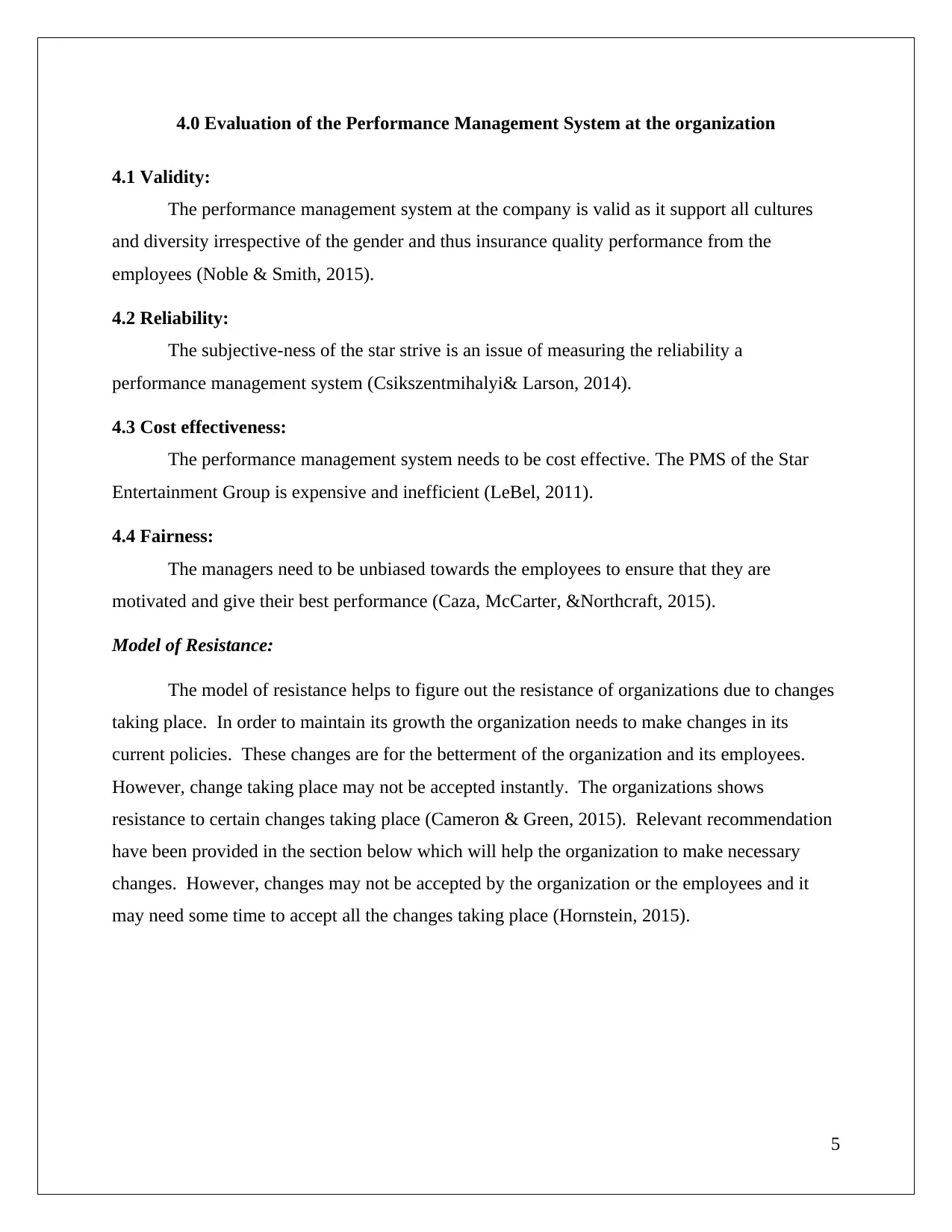
4.0 Evaluation of the Performance Management System at the organization
4.1 Validity:
The performance management system at the company is valid as it support all cultures
and diversity irrespective of the gender and thus insurance quality performance from the
employees (Noble & Smith, 2015).
4.2 Reliability:
The subjective-ness of the star strive is an issue of measuring the reliability a
performance management system (Csikszentmihalyi& Larson, 2014).
4.3 Cost effectiveness:
The performance management system needs to be cost effective. The PMS of the Star
Entertainment Group is expensive and inefficient (LeBel, 2011).
4.4 Fairness:
The managers need to be unbiased towards the employees to ensure that they are
motivated and give their best performance (Caza, McCarter, &Northcraft, 2015).
Model of Resistance:
The model of resistance helps to figure out the resistance of organizations due to changes
taking place. In order to maintain its growth the organization needs to make changes in its
current policies. These changes are for the betterment of the organization and its employees.
However, change taking place may not be accepted instantly. The organizations shows
resistance to certain changes taking place (Cameron & Green, 2015). Relevant recommendation
have been provided in the section below which will help the organization to make necessary
changes. However, changes may not be accepted by the organization or the employees and it
may need some time to accept all the changes taking place (Hornstein, 2015).
5
4.1 Validity:
The performance management system at the company is valid as it support all cultures
and diversity irrespective of the gender and thus insurance quality performance from the
employees (Noble & Smith, 2015).
4.2 Reliability:
The subjective-ness of the star strive is an issue of measuring the reliability a
performance management system (Csikszentmihalyi& Larson, 2014).
4.3 Cost effectiveness:
The performance management system needs to be cost effective. The PMS of the Star
Entertainment Group is expensive and inefficient (LeBel, 2011).
4.4 Fairness:
The managers need to be unbiased towards the employees to ensure that they are
motivated and give their best performance (Caza, McCarter, &Northcraft, 2015).
Model of Resistance:
The model of resistance helps to figure out the resistance of organizations due to changes
taking place. In order to maintain its growth the organization needs to make changes in its
current policies. These changes are for the betterment of the organization and its employees.
However, change taking place may not be accepted instantly. The organizations shows
resistance to certain changes taking place (Cameron & Green, 2015). Relevant recommendation
have been provided in the section below which will help the organization to make necessary
changes. However, changes may not be accepted by the organization or the employees and it
may need some time to accept all the changes taking place (Hornstein, 2015).
5
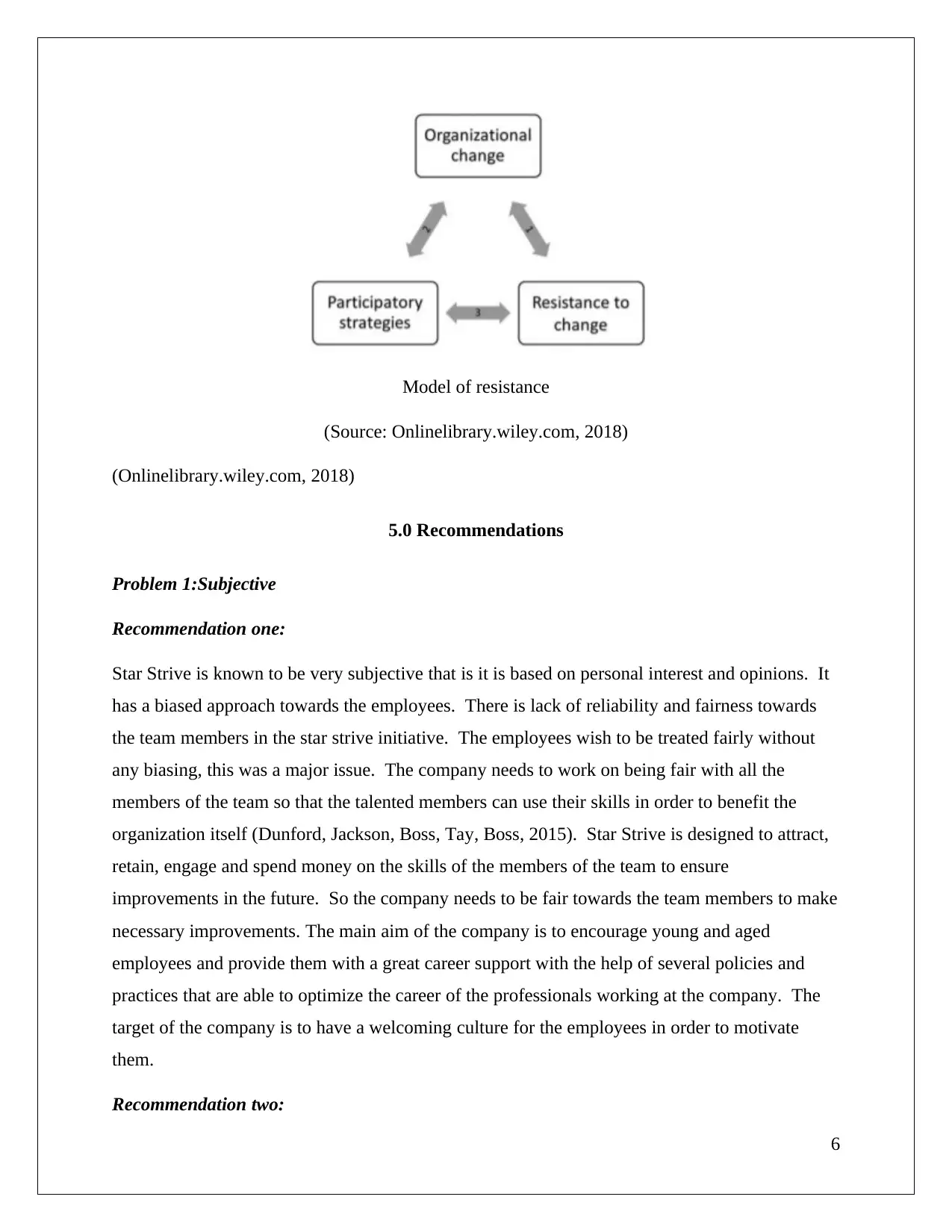
Model of resistance
(Source: Onlinelibrary.wiley.com, 2018)
(Onlinelibrary.wiley.com, 2018)
5.0 Recommendations
Problem 1:Subjective
Recommendation one:
Star Strive is known to be very subjective that is it is based on personal interest and opinions. It
has a biased approach towards the employees. There is lack of reliability and fairness towards
the team members in the star strive initiative. The employees wish to be treated fairly without
any biasing, this was a major issue. The company needs to work on being fair with all the
members of the team so that the talented members can use their skills in order to benefit the
organization itself (Dunford, Jackson, Boss, Tay, Boss, 2015). Star Strive is designed to attract,
retain, engage and spend money on the skills of the members of the team to ensure
improvements in the future. So the company needs to be fair towards the team members to make
necessary improvements. The main aim of the company is to encourage young and aged
employees and provide them with a great career support with the help of several policies and
practices that are able to optimize the career of the professionals working at the company. The
target of the company is to have a welcoming culture for the employees in order to motivate
them.
Recommendation two:
6
(Source: Onlinelibrary.wiley.com, 2018)
(Onlinelibrary.wiley.com, 2018)
5.0 Recommendations
Problem 1:Subjective
Recommendation one:
Star Strive is known to be very subjective that is it is based on personal interest and opinions. It
has a biased approach towards the employees. There is lack of reliability and fairness towards
the team members in the star strive initiative. The employees wish to be treated fairly without
any biasing, this was a major issue. The company needs to work on being fair with all the
members of the team so that the talented members can use their skills in order to benefit the
organization itself (Dunford, Jackson, Boss, Tay, Boss, 2015). Star Strive is designed to attract,
retain, engage and spend money on the skills of the members of the team to ensure
improvements in the future. So the company needs to be fair towards the team members to make
necessary improvements. The main aim of the company is to encourage young and aged
employees and provide them with a great career support with the help of several policies and
practices that are able to optimize the career of the professionals working at the company. The
target of the company is to have a welcoming culture for the employees in order to motivate
them.
Recommendation two:
6
⊘ This is a preview!⊘
Do you want full access?
Subscribe today to unlock all pages.

Trusted by 1+ million students worldwide
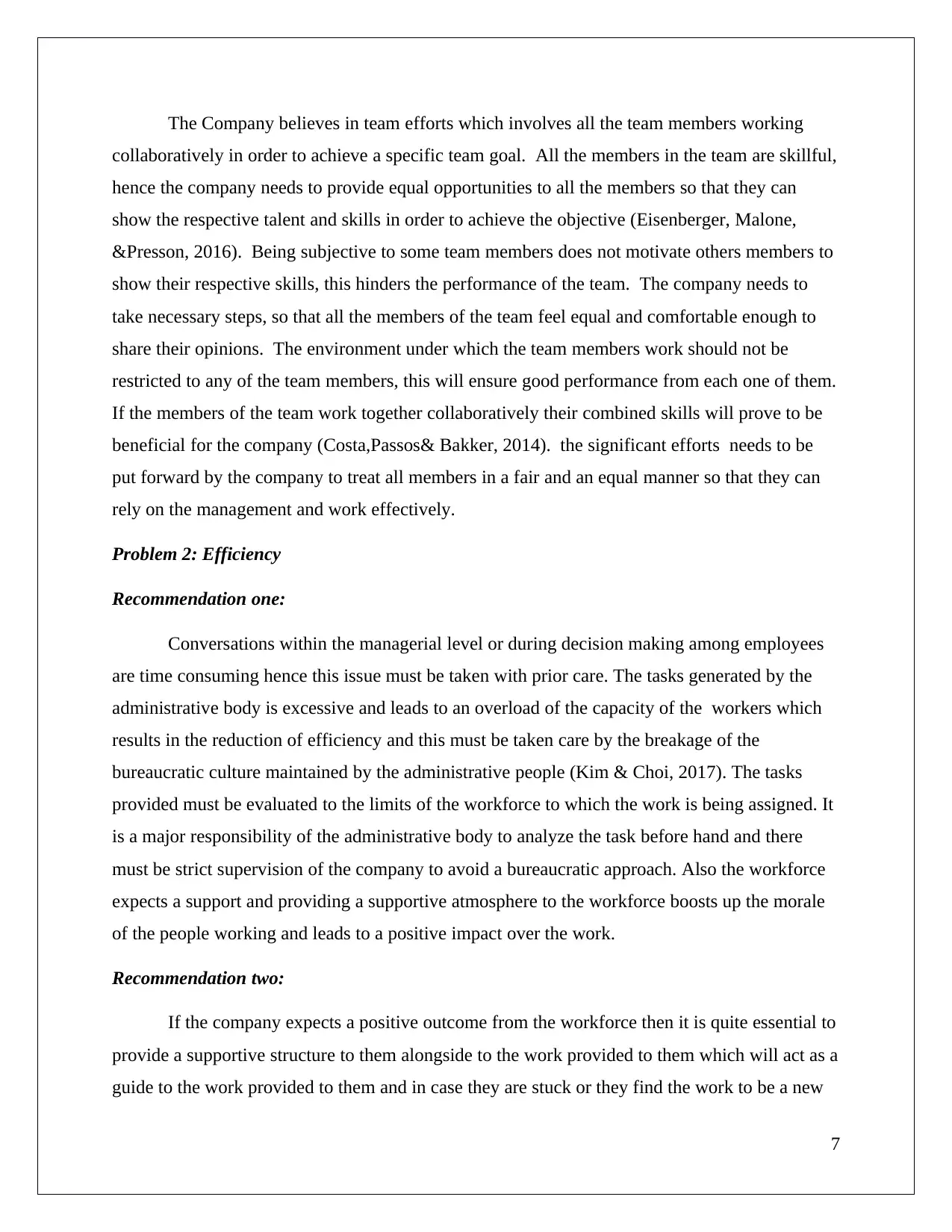
The Company believes in team efforts which involves all the team members working
collaboratively in order to achieve a specific team goal. All the members in the team are skillful,
hence the company needs to provide equal opportunities to all the members so that they can
show the respective talent and skills in order to achieve the objective (Eisenberger, Malone,
&Presson, 2016). Being subjective to some team members does not motivate others members to
show their respective skills, this hinders the performance of the team. The company needs to
take necessary steps, so that all the members of the team feel equal and comfortable enough to
share their opinions. The environment under which the team members work should not be
restricted to any of the team members, this will ensure good performance from each one of them.
If the members of the team work together collaboratively their combined skills will prove to be
beneficial for the company (Costa,Passos& Bakker, 2014). the significant efforts needs to be
put forward by the company to treat all members in a fair and an equal manner so that they can
rely on the management and work effectively.
Problem 2: Efficiency
Recommendation one:
Conversations within the managerial level or during decision making among employees
are time consuming hence this issue must be taken with prior care. The tasks generated by the
administrative body is excessive and leads to an overload of the capacity of the workers which
results in the reduction of efficiency and this must be taken care by the breakage of the
bureaucratic culture maintained by the administrative people (Kim & Choi, 2017). The tasks
provided must be evaluated to the limits of the workforce to which the work is being assigned. It
is a major responsibility of the administrative body to analyze the task before hand and there
must be strict supervision of the company to avoid a bureaucratic approach. Also the workforce
expects a support and providing a supportive atmosphere to the workforce boosts up the morale
of the people working and leads to a positive impact over the work.
Recommendation two:
If the company expects a positive outcome from the workforce then it is quite essential to
provide a supportive structure to them alongside to the work provided to them which will act as a
guide to the work provided to them and in case they are stuck or they find the work to be a new
7
collaboratively in order to achieve a specific team goal. All the members in the team are skillful,
hence the company needs to provide equal opportunities to all the members so that they can
show the respective talent and skills in order to achieve the objective (Eisenberger, Malone,
&Presson, 2016). Being subjective to some team members does not motivate others members to
show their respective skills, this hinders the performance of the team. The company needs to
take necessary steps, so that all the members of the team feel equal and comfortable enough to
share their opinions. The environment under which the team members work should not be
restricted to any of the team members, this will ensure good performance from each one of them.
If the members of the team work together collaboratively their combined skills will prove to be
beneficial for the company (Costa,Passos& Bakker, 2014). the significant efforts needs to be
put forward by the company to treat all members in a fair and an equal manner so that they can
rely on the management and work effectively.
Problem 2: Efficiency
Recommendation one:
Conversations within the managerial level or during decision making among employees
are time consuming hence this issue must be taken with prior care. The tasks generated by the
administrative body is excessive and leads to an overload of the capacity of the workers which
results in the reduction of efficiency and this must be taken care by the breakage of the
bureaucratic culture maintained by the administrative people (Kim & Choi, 2017). The tasks
provided must be evaluated to the limits of the workforce to which the work is being assigned. It
is a major responsibility of the administrative body to analyze the task before hand and there
must be strict supervision of the company to avoid a bureaucratic approach. Also the workforce
expects a support and providing a supportive atmosphere to the workforce boosts up the morale
of the people working and leads to a positive impact over the work.
Recommendation two:
If the company expects a positive outcome from the workforce then it is quite essential to
provide a supportive structure to them alongside to the work provided to them which will act as a
guide to the work provided to them and in case they are stuck or they find the work to be a new
7
Paraphrase This Document
Need a fresh take? Get an instant paraphrase of this document with our AI Paraphraser

one or a tough one then it would not be hard for them to bring their work back on track within
short time. This procedure will render a long time positive effect on the impact and the
development processes will bloom with greater efficiencies. Adding a bit of management of the
amount of task being assigned and monitoring that the work load does not become excessive will
help amplify the efficiency more and reduced risk of forced work due to the administrative
decisions.
Problem 3: Lack of stable leadership capabilities
Recommendation one:
The major setback in a company arises if the leadership capabilities are not worthy of the
expectation they are put up to. The first thing that must be done is people with great leadership
skills must be placed in managerial levels and this leaders will be placed in the internal and
external aspects (Fairhurst&Connaughton, 2014). All inexperienced supervisors must be taken
care of in the sense that they must not be provided with full authority to evaluate the employees
as because this this would lead to false analysis due the supervisor’s lack of experiences. This
kind of false analysis can lead to lack of morale among the workforce hence a blend of
experienced and inexperienced must be properly done to avoid risking this false evaluation of the
employees and it would be better to keep the number of inexperienced supervisors as less as
possible and this would improve the leadership capabilities which would also be stable.
Recommendation two:
The fairness of ratings for the employees must be properly monitored. A biased decision
from the managerial level leads to a harsh rating for the employees. There arises different
expectations ofdifferent levels and this must be subsequently met which would establish a strong
leadership message. Also improvising different levels of expertise will help approach the
problems with a new approach and hence would lead to newness and the expectations arising
would be met differently in a much appreciated way. This practice would cheer up the work
force and establish a stable leadership scheme. The leader must take up the responsibility to
make and understand the workforce that common level of rating cannot be given to all as this is
8
short time. This procedure will render a long time positive effect on the impact and the
development processes will bloom with greater efficiencies. Adding a bit of management of the
amount of task being assigned and monitoring that the work load does not become excessive will
help amplify the efficiency more and reduced risk of forced work due to the administrative
decisions.
Problem 3: Lack of stable leadership capabilities
Recommendation one:
The major setback in a company arises if the leadership capabilities are not worthy of the
expectation they are put up to. The first thing that must be done is people with great leadership
skills must be placed in managerial levels and this leaders will be placed in the internal and
external aspects (Fairhurst&Connaughton, 2014). All inexperienced supervisors must be taken
care of in the sense that they must not be provided with full authority to evaluate the employees
as because this this would lead to false analysis due the supervisor’s lack of experiences. This
kind of false analysis can lead to lack of morale among the workforce hence a blend of
experienced and inexperienced must be properly done to avoid risking this false evaluation of the
employees and it would be better to keep the number of inexperienced supervisors as less as
possible and this would improve the leadership capabilities which would also be stable.
Recommendation two:
The fairness of ratings for the employees must be properly monitored. A biased decision
from the managerial level leads to a harsh rating for the employees. There arises different
expectations ofdifferent levels and this must be subsequently met which would establish a strong
leadership message. Also improvising different levels of expertise will help approach the
problems with a new approach and hence would lead to newness and the expectations arising
would be met differently in a much appreciated way. This practice would cheer up the work
force and establish a stable leadership scheme. The leader must take up the responsibility to
make and understand the workforce that common level of rating cannot be given to all as this is
8
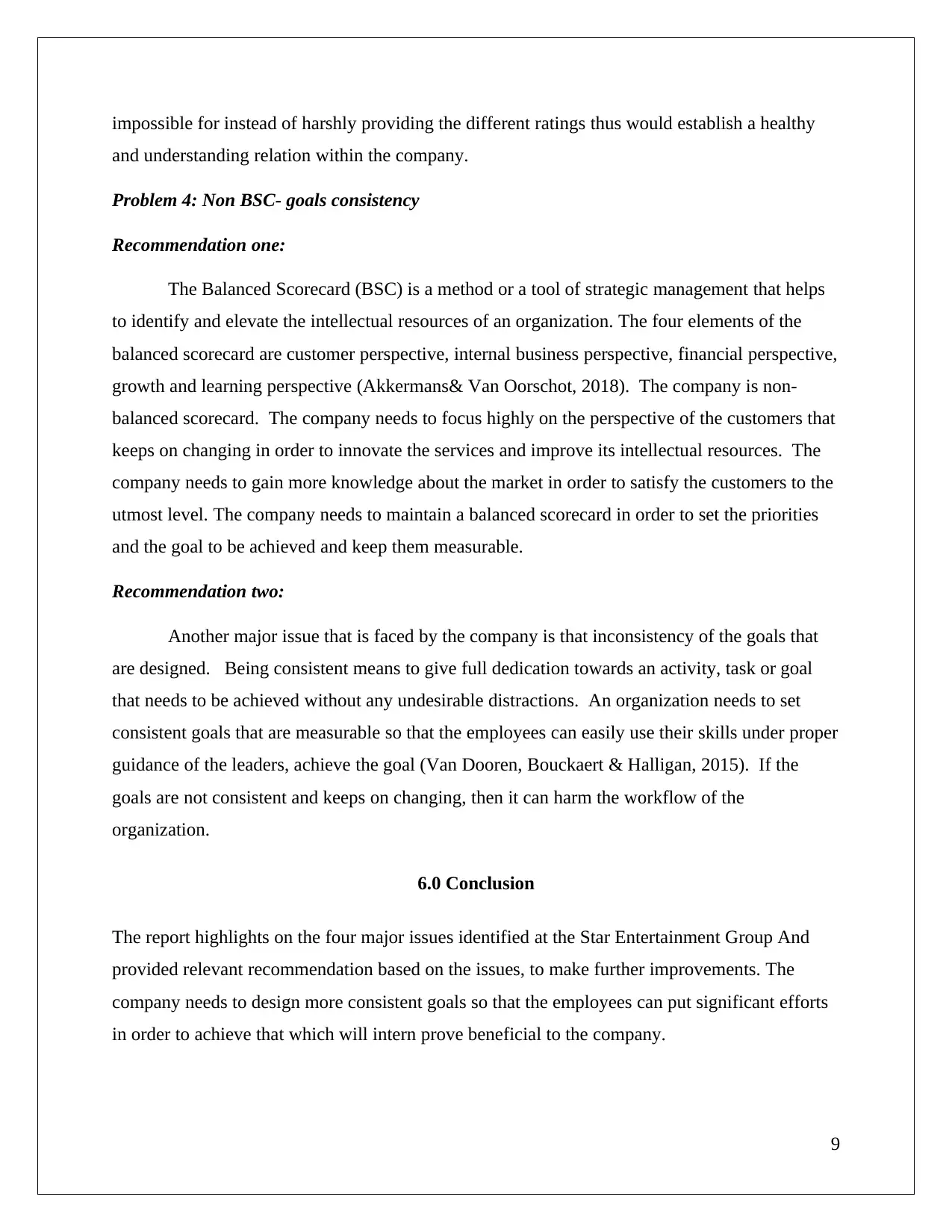
impossible for instead of harshly providing the different ratings thus would establish a healthy
and understanding relation within the company.
Problem 4: Non BSC- goals consistency
Recommendation one:
The Balanced Scorecard (BSC) is a method or a tool of strategic management that helps
to identify and elevate the intellectual resources of an organization. The four elements of the
balanced scorecard are customer perspective, internal business perspective, financial perspective,
growth and learning perspective (Akkermans& Van Oorschot, 2018). The company is non-
balanced scorecard. The company needs to focus highly on the perspective of the customers that
keeps on changing in order to innovate the services and improve its intellectual resources. The
company needs to gain more knowledge about the market in order to satisfy the customers to the
utmost level. The company needs to maintain a balanced scorecard in order to set the priorities
and the goal to be achieved and keep them measurable.
Recommendation two:
Another major issue that is faced by the company is that inconsistency of the goals that
are designed. Being consistent means to give full dedication towards an activity, task or goal
that needs to be achieved without any undesirable distractions. An organization needs to set
consistent goals that are measurable so that the employees can easily use their skills under proper
guidance of the leaders, achieve the goal (Van Dooren, Bouckaert & Halligan, 2015). If the
goals are not consistent and keeps on changing, then it can harm the workflow of the
organization.
6.0 Conclusion
The report highlights on the four major issues identified at the Star Entertainment Group And
provided relevant recommendation based on the issues, to make further improvements. The
company needs to design more consistent goals so that the employees can put significant efforts
in order to achieve that which will intern prove beneficial to the company.
9
and understanding relation within the company.
Problem 4: Non BSC- goals consistency
Recommendation one:
The Balanced Scorecard (BSC) is a method or a tool of strategic management that helps
to identify and elevate the intellectual resources of an organization. The four elements of the
balanced scorecard are customer perspective, internal business perspective, financial perspective,
growth and learning perspective (Akkermans& Van Oorschot, 2018). The company is non-
balanced scorecard. The company needs to focus highly on the perspective of the customers that
keeps on changing in order to innovate the services and improve its intellectual resources. The
company needs to gain more knowledge about the market in order to satisfy the customers to the
utmost level. The company needs to maintain a balanced scorecard in order to set the priorities
and the goal to be achieved and keep them measurable.
Recommendation two:
Another major issue that is faced by the company is that inconsistency of the goals that
are designed. Being consistent means to give full dedication towards an activity, task or goal
that needs to be achieved without any undesirable distractions. An organization needs to set
consistent goals that are measurable so that the employees can easily use their skills under proper
guidance of the leaders, achieve the goal (Van Dooren, Bouckaert & Halligan, 2015). If the
goals are not consistent and keeps on changing, then it can harm the workflow of the
organization.
6.0 Conclusion
The report highlights on the four major issues identified at the Star Entertainment Group And
provided relevant recommendation based on the issues, to make further improvements. The
company needs to design more consistent goals so that the employees can put significant efforts
in order to achieve that which will intern prove beneficial to the company.
9
⊘ This is a preview!⊘
Do you want full access?
Subscribe today to unlock all pages.

Trusted by 1+ million students worldwide

7.0 References
Aguinis, H. (2013). Performance management (Vol. 2). Boston, MA: Pearson.
Akkermans, H. A., & Van Oorschot, K. E. (2018). Relevance assumed: a case study of balanced
scorecard development using system dynamics. In System Dynamics (pp. 107-132).
Palgrave Macmillan, London.
Berger, L. A., & Berger, D. R. (Eds.). (2011). The talent management handbook: Creating a
sustainable competitive advantage by selecting, developing, and promoting the best
people. New York: McGraw-Hill.
Cameron, E., & Green, M. (2015). Making sense of change management: A complete guide to
the models, tools and techniques of organizational change. Kogan Page Publishers.
Caza, A., McCarter, M. W., &Northcraft, G. B. (2015). Performance benefits of reward choice:
A procedural justice perspective. Human Resource Management Journal, 25(2), 184-199.
Costa, P. L., Passos, A. M., & Bakker, A. B. (2014). Team work engagement: A model of
emergence. Journal of Occupational and Organizational Psychology, 87(2), 414-436.
Dunford, B. B., Jackson, C. L., Boss, A. D., Tay, L., & Boss, R. W. (2015). Be fair, your
employees are watching: A relational response model of external third‐party justice.
Personnel Psychology, 68(2), 319-352.
Eisenberger, R., Malone, G. P., & Presson, W. D. (2016). Optimizing perceived organizational
support to enhance employee engagement. Society for Human Resource Management
and Society for Industrial and Organizational Psychology, 2-22.
Fairhurst, G. T., &Connaughton, S. L. (2014). Leadership: A communicative perspective.
Leadership, 10(1), 7-35.
Gruman, J. A., & Saks, A. M. (2011). Performance management and employee engagement.
Human Resource Management Review, 21(2), 123-136.
10
Aguinis, H. (2013). Performance management (Vol. 2). Boston, MA: Pearson.
Akkermans, H. A., & Van Oorschot, K. E. (2018). Relevance assumed: a case study of balanced
scorecard development using system dynamics. In System Dynamics (pp. 107-132).
Palgrave Macmillan, London.
Berger, L. A., & Berger, D. R. (Eds.). (2011). The talent management handbook: Creating a
sustainable competitive advantage by selecting, developing, and promoting the best
people. New York: McGraw-Hill.
Cameron, E., & Green, M. (2015). Making sense of change management: A complete guide to
the models, tools and techniques of organizational change. Kogan Page Publishers.
Caza, A., McCarter, M. W., &Northcraft, G. B. (2015). Performance benefits of reward choice:
A procedural justice perspective. Human Resource Management Journal, 25(2), 184-199.
Costa, P. L., Passos, A. M., & Bakker, A. B. (2014). Team work engagement: A model of
emergence. Journal of Occupational and Organizational Psychology, 87(2), 414-436.
Dunford, B. B., Jackson, C. L., Boss, A. D., Tay, L., & Boss, R. W. (2015). Be fair, your
employees are watching: A relational response model of external third‐party justice.
Personnel Psychology, 68(2), 319-352.
Eisenberger, R., Malone, G. P., & Presson, W. D. (2016). Optimizing perceived organizational
support to enhance employee engagement. Society for Human Resource Management
and Society for Industrial and Organizational Psychology, 2-22.
Fairhurst, G. T., &Connaughton, S. L. (2014). Leadership: A communicative perspective.
Leadership, 10(1), 7-35.
Gruman, J. A., & Saks, A. M. (2011). Performance management and employee engagement.
Human Resource Management Review, 21(2), 123-136.
10
Paraphrase This Document
Need a fresh take? Get an instant paraphrase of this document with our AI Paraphraser
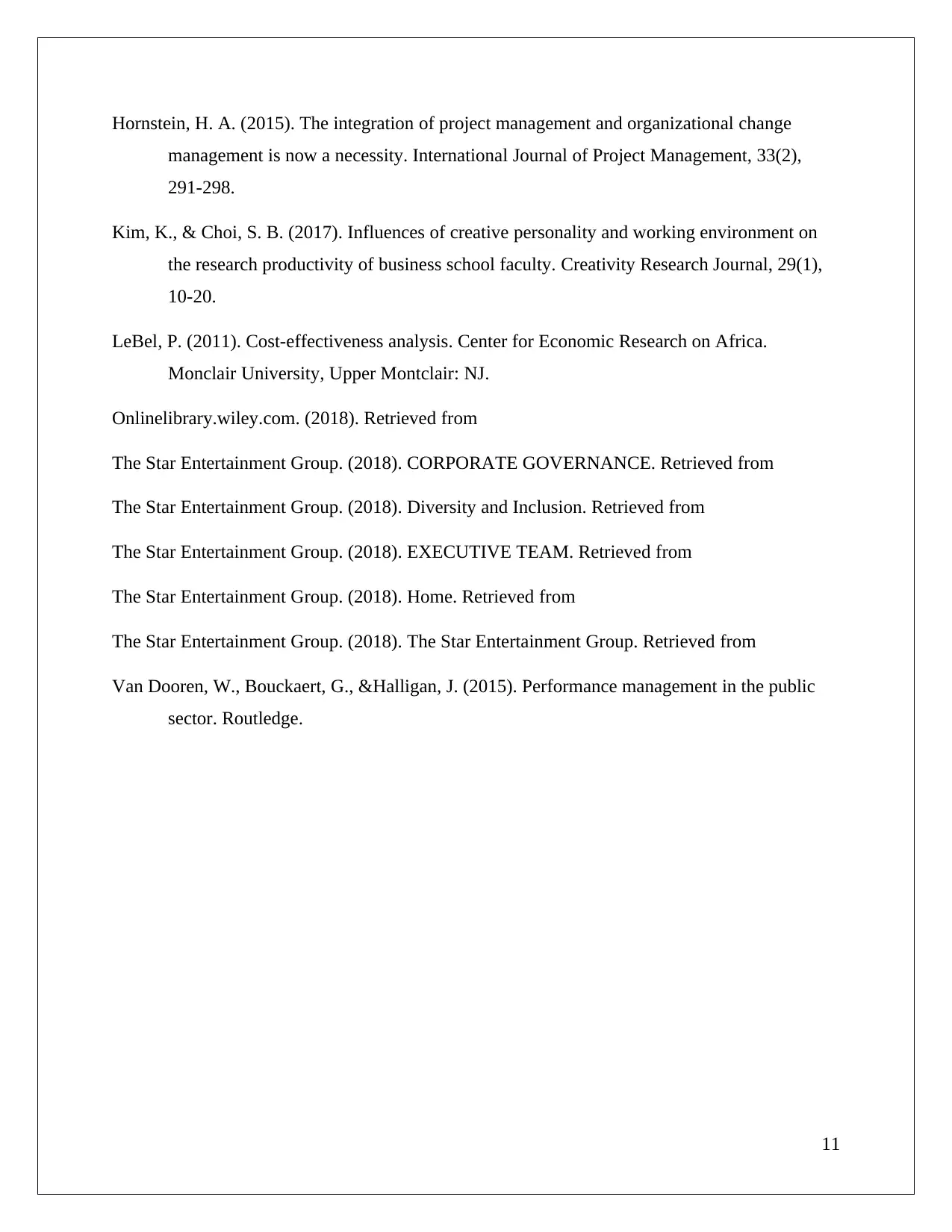
Hornstein, H. A. (2015). The integration of project management and organizational change
management is now a necessity. International Journal of Project Management, 33(2),
291-298.
Kim, K., & Choi, S. B. (2017). Influences of creative personality and working environment on
the research productivity of business school faculty. Creativity Research Journal, 29(1),
10-20.
LeBel, P. (2011). Cost-effectiveness analysis. Center for Economic Research on Africa.
Monclair University, Upper Montclair: NJ.
Onlinelibrary.wiley.com. (2018). Retrieved from
The Star Entertainment Group. (2018). CORPORATE GOVERNANCE. Retrieved from
The Star Entertainment Group. (2018). Diversity and Inclusion. Retrieved from
The Star Entertainment Group. (2018). EXECUTIVE TEAM. Retrieved from
The Star Entertainment Group. (2018). Home. Retrieved from
The Star Entertainment Group. (2018). The Star Entertainment Group. Retrieved from
Van Dooren, W., Bouckaert, G., &Halligan, J. (2015). Performance management in the public
sector. Routledge.
11
management is now a necessity. International Journal of Project Management, 33(2),
291-298.
Kim, K., & Choi, S. B. (2017). Influences of creative personality and working environment on
the research productivity of business school faculty. Creativity Research Journal, 29(1),
10-20.
LeBel, P. (2011). Cost-effectiveness analysis. Center for Economic Research on Africa.
Monclair University, Upper Montclair: NJ.
Onlinelibrary.wiley.com. (2018). Retrieved from
The Star Entertainment Group. (2018). CORPORATE GOVERNANCE. Retrieved from
The Star Entertainment Group. (2018). Diversity and Inclusion. Retrieved from
The Star Entertainment Group. (2018). EXECUTIVE TEAM. Retrieved from
The Star Entertainment Group. (2018). Home. Retrieved from
The Star Entertainment Group. (2018). The Star Entertainment Group. Retrieved from
Van Dooren, W., Bouckaert, G., &Halligan, J. (2015). Performance management in the public
sector. Routledge.
11
1 out of 11
Related Documents
Your All-in-One AI-Powered Toolkit for Academic Success.
+13062052269
info@desklib.com
Available 24*7 on WhatsApp / Email
![[object Object]](/_next/static/media/star-bottom.7253800d.svg)
Unlock your academic potential
Copyright © 2020–2025 A2Z Services. All Rights Reserved. Developed and managed by ZUCOL.





